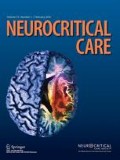You described a problem. DID NOTHING to solve it. Useless.
Association Between Hypoperfusion Intensity Ratio and Postthrombectomy Malignant Brain Edema for Acute Ischemic Stroke
Abstract
Background
Malignant brain edema (MBE) is a life-threatening complication that can occur after mechanical thrombectomy (MT) for acute ischemic stroke. The hypoperfusion intensity ratio (HIR) reflects the tissue-level perfusion status within the ischemic territory. This study investigated the association between HIR and MBE occurrence after MT in patients with anterior circulation large artery occlusion.
Methods
We conducted a retrospective cohort study of patients who received MT at a comprehensive stroke center from February 2020 to June 2022. Using computed tomography perfusion, the HIR was derived from the ratio of tissue volume with a time to maximum (Tmax) > 10 s to that with a Tmax > 6 s. We dichotomized patients based on the occurrence of MBE following MT. The primary outcome, assessed using a multivariable logistic regression model, was the MBE occurrence post MT. The secondary outcome focused on favorable outcomes, defined as achieving a modified Rankin Scale score of 0–2 at 90 days.
Results
Of the 603 included patients, 90 (14.9%) developed MBE after MT. The median HIR exhibited a significantly higher value in the MBE group compared with the non-MBE group (0.5 vs. 0.3; P < 0.001). Multivariable logistic regression analysis indicated that a higher HIR (adjusted odds ratio [aOR] 8.98; 95% confidence interval [CI] 2.85–28.25; P < 0.001), baseline large infarction (Alberta Stroke Program Early Computed Tomography Score < 6; aOR 1.77; 95% CI 1.04–3.01; P = 0.035), internal carotid artery occlusion (aOR 1.80; 95% CI 1.07–3.01; P = 0.028), and unsuccessful recanalization (aOR 8.45; 95% CI 4.75–15.03; P < 0.001) were independently associated with MBE post MT. Among those with successful recanalization, a higher HIR (P = 0.017) and baseline large infarction (P = 0.032) remained as predictors of MBE occurrence. Furthermore, a higher HIR (P = 0.001) and the occurrence of MBE (P < 0.001) both correlated with reduced odds of achieving favorable outcomes.
Conclusions
The presence of a higher HIR on pretreatment perfusion imaging serves as a robust predictor for MBE occurrence after MT, irrespective of successful recanalization.

No comments:
Post a Comment